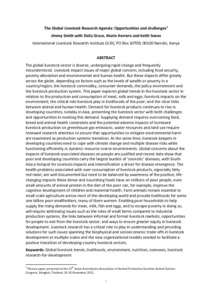Resource information
The global livestock sector is diverse, undergoing rapid change and frequently
misunderstood. Livestock impact issues of major global concern, including food security,
poverty alleviation and environmental and human health. But these impacts differ greatly
across the globe, depending on factors such as the levels of wealth or poverty in a
country/region, the livestock commodity, consumer demands, the policy environment and
the livestock production system. This paper explores global trends in the livestock sector in
relation to the production and consumption of meat, milk and eggs; livestock impacts on the
environment; the critical role livestock play in livelihoods of the poor; and the close links
between animal and human health. Demand for livestock products continues to rise in
developing countries, notably in Asia, presenting the livestock sector with both challenges
and opportunities in meeting this demand. Supplying demand requires overcoming feed,
breed and animal health constraints and the potential adverse impacts of increased
livestock production on greenhouse gas emissions, water resources and land use require
renewed research attention to ensure that opportunities to mitigate environmental harm
are maximized as production systems transition. At the same time, livestock keepers in
developing countries need to cope with climate change and multiple disease risks while
functioning efficiently in dynamic resource?scarce environments. Global concerns about the
impacts of livestock?associated diseases on people are justified and recent data show that
poor and developing countries carry the largest burden of ‘zoonotic’ diseases, with South
Asia a hotspot for zoonosis impacts and intensification a driver for disease emergence. The
health problems associated with over?consumption of livestock products, especially fatty
red meat, are well documented but need to be balanced by awareness of the positive, lifechanging
impacts these dense and nourishing foods have on millions of poor people; even
small amounts of animal protein in the diet of the poor can, for example, improve the
cognitive development of children and maternal health. Farm animals remain essential to
small?scale agriculture across most of the developing world and provide livelihoods for some
one billion poor smallholders, many of them women. Enabling poor households to help
supply the rising demands for meat, milk, fish and eggs, and to escape poverty in doing so,
will require addressing issues such as the roles of small farms compared to industrial
production systems, the links between informal and formal livestock markets, opportunities
for people to exit from the livestock sector, and ways to ensure greater equity in livestock
development. Livestock research has a critical role to play in understanding and providing
solutions for such issues spanning the biophysical and socioeconomic trade?offs in livestock
development at multiple scales and the new organizational models needed to facilitate a
positive transition of developing?country livestock sectors.


